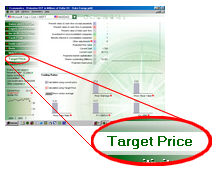Target Price
 In the previous
chapters we discussed various steps to make projections of free cash flow
and weighted average cost of capital (WACC). In this last window (Target price), we discuss further required
steps to calculate the share's target price and its respective growth
(upside) or decline potential.
In the previous
chapters we discussed various steps to make projections of free cash flow
and weighted average cost of capital (WACC). In this last window (Target price), we discuss further required
steps to calculate the share's target price and its respective growth
(upside) or decline potential.
This chapter is comprised
of the topics listed below. Click on the desired topic to move automatically
to its corresponding description.
The
current year is partially accounted
Factors
to be added or subtracted from the present value of the cash flow
The portion
of the company that belongs to the shareholders
Projections
must be generated again following share issuances
The current year is partially accounted
: In calculating the present value of the cash flow projected in the period
it is worth noting that the current year is accounted for on a prorata
basis taking into consideration the remaining days of the year.
Example: Suppose that today
is 20-Aug-05 and therefore 232 days have transpired and 133 days yet remain
in the year. In this case the system would take into account the equivalent
of 36.4% (=133/365) of the cash flow projected for 2005.
The discount rate would
also be accounted for proportionally in the year.
WACCp = (1 + WACCt) ^ (133/365)
were:
WACCp is the cost of capital
for the remainder of the year
WACCt is
the projected cost of capital for the entire year
Factors to be added or subtracted from the
present value of the cash flow : The present value of the cash
flow is equivalent to the value of all the underlying assets comprising
this cash flow. As the company may hold nonoperating assets, we need to
add the respective values of such assets to the present value of the cash
flow in order to obtain the target price of the company. Similarly, the
company may hold nonoperating liablities which would need to be subtracted
from the present value of the cash flow to obtain the target price of
the company. The factors are:
- Investment in subsidiaries
and others (+)
- Minority interests (-)
- Other adjustments (+)
The values of the first
two factors are extracted automatically by the system from the most recent
financial statement available. The third factor should be entered by the
user should he consider any special
adjustments need to be made.
The portion of the company that belongs
to the shareholders : To obtain the value of the company that corresponds
to the shareholders (fair market cap), we subtract the value of the net
debt (=total debt minus cash and short-term investments) from the value
of the company. These values are obtained from the company's most recent
financial statement.
Finally, in order to determine
the target price of the stock we divide the fair market cap by the total
number of shares outstanding.
Projections must be made again following share issuances
: When a company issues a significant number of new shares (IPO,
acquisition of another company, etc.), the increase in the shares outstanding
results in an artificial reduction of the target price.
To return to a target price
that is again representative the user most re-do the projection of the
cash flow so that it properly reflects the increase in operations expected
from the share issuance.
 In the previous
chapters we discussed various steps to make projections of free cash flow
and weighted average cost of capital (WACC). In this last window (Target price), we discuss further required
steps to calculate the share's target price and its respective growth
(upside) or decline potential.
In the previous
chapters we discussed various steps to make projections of free cash flow
and weighted average cost of capital (WACC). In this last window (Target price), we discuss further required
steps to calculate the share's target price and its respective growth
(upside) or decline potential.